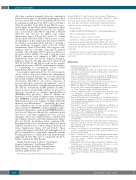Page 250 - 2021_04-Haematologica-web
P. 250
1166
Letters to the Editor
effect was considered synergistic when the combination index (CI) had a value <1. An inhibitory synergistic effect was detected for PGL-13 (CI=0.64) and PGL-14 (CI=0.78) in combination with Ara-C for THP-1, but not for KG-1 (CI=1.24 and CI=1.10 for PGL-13 and PGL-14, respec- tively) (Figure 2C and D and Online Supplementary Figure S4A and B). A similar inhibitory effect for the combina- tion of doxorubicin with PGL-13 (CI=0.53) or PGL-14 (CI=0.76) was detected in THP-1 cells (Online Supplementary Figures S3D and S4C and D). To confirm the specificity of the PGL, THP-1 cells were also co-treat- ed with maltose (a disaccharide known to bind to GLUT1 but which is non-transportable) and Ara-C, showing a clear inhibitory synergistic effect (CI=0.82) (Online Supplementary Figures S3E and S4E). This suggests a sen- sitization effect by both PGL compounds in myeloid leukemia cells with high GLUT1 expression. However, also Mono-Mac-6 (MM6) cells with a clear but lower GLUT1 expression level compared to THP-1 (Online Supplementary Figure S2A and B) displayed synergistic inhibitory effects for the PGL with Ara-C (CI=0.62 and CI=0.53, for PGL-13 and PGL-14, respectively), suggest- ing that the presence of GLUT1, rather than the amounts, is contributing to sensitization effects (Online Supplementary Figures S3A-C and S4F and G).
A mechanistic explanation for the observed synergistic effects could be that Ara-C inhibits the Akt-pathway resulting in increased dependence on aerobic glycolysis that in turn is inhibited by PGL. This is supported by the observations that PGL-13 can restore repression of increased glycolysis caused by Akt inhibitors,11 and by the suggestions that Ara-C can inhibit phosphorylation of Akt and the downstream mTOR pathway in AML.12 However, Ara-C resistant AML cells have been shown to rather be dependent on oxidative phosphorylation (OXPHOS) than glycolysis.13 Thus, to validate the hypothesis, we also targeted dihydroorotate dehydroge- nase (DHODH) a known putative metabolic target for AML therapy and a potent regulator of AML cell growth, apoptosis and differentiation.14,15 Specifically, the oxida- tion of dihydroorotate via the activity of DHODH pro- vides electrons for OXPHOS. A distinct inhibition of pro- liferation by Brequinar, a well-studied DHODH inhibitor, was detected. However, although the combination index was close to 1 (CI values ranging from 1.00 to 1.20), no synergistic effects were displayed when combined with Ara-C (Figure 2E and F, and Online Supplementary Figures S3F and S5A-D). In addition, when combining PGL, Brequinar and Ara-C the outcome was similar as to when only PGL and Ara-C were combined (Figure 2E and F, and Online Supplementary Figures S3F and S5A-D). Taken together, this suggests that AML cells with high levels of glucose transporters are particularly vulnerable towards blocking glycolysis in combination with chemotherapy, suggesting that the PGL class of compounds should be further evaluated for AML therapy.
Biology, BMC C13, Lund University, Lund, Sweden; 2Department of Laboratory Medicine, Division of Clinical Genetics, BMC C13, Lund University, Lund, Sweden; 3Department of Pharmacy, University of Pisa, Pisa, Italy and 4LINXS - Lund Institute of Advanced Neutron and X-ray Science, Scheelevägen 19, SE-223 70, Lund, Sweden
Correspondence:
KARIN LINDKVIST-PETERSSON - karin.lindkvist@med.lu.se doi:10.3324/haematol.2020.246843
Disclosures: no conflicts of interest to disclose.
Contributions: HÅ, JH, AH-W, TT, FM, AKH-A and KL-P designed the experiments; HÅ, JH, PH, RV, AH-W, GP and CG conducted the experiments; HÅ, JH, RV, TT, FM, AKH-A and KL-P analyzed the data; HÅ, RV, TT, FM, AKH-A and KL-P wrote the manuscript.
Funding: this work was supported by Swedish Research Council (2016-01319 and 2017-05816) and the Swedish Cancer Society (2017/307).
References
1.Warburg O. On respiratory impairment in cancer cells. Science. 1956;124(3215):269-270.
2. Chen WL, Wang JH, Zhao AH, et al. A distinct glucose metabolism signature of acute myeloid leukemia with prognostic value. Blood. 2014;124(10):1645-1654.
3. Saito Y, Chapple RH, Lin A, Kitano A, Nakada D. AMPK protects leukemia-initiating cells in myeloid leukemias from metabolic stress in the bone marrow. Cell Stem Cell. 2015;17(5):585-596.
4. Deng D, Xu C, Sun P, et al. Crystal structure of the human glucose transporter GLUT1. Nature. 2014;510(7503):121-125.
5.Hansen JS, Elbing K, Thompson JR, Malmstadt N, Lindkvist- Petersson K. Glucose transport machinery reconstituted in cell mod- els. Chem Commun (Camb). 2015;51(12):2316-2319.
6. Granchi C, Qian Y, Lee HY, et al. Salicylketoximes that target glu- cose transporter 1 restrict energy supply to lung cancer cells. ChemMedChem. 2015;10(11):1892-1900.
7. Kapoor K, Finer-Moore JS, Pedersen BP, et al. Mechanism of inhibi- tion of human glucose transporter GLUT1 is conserved between cytochalasin B and phenylalanine amides. Proc Natl Acad Sci U S A. 2016;113(17):4711-4716.
8. Tuccinardi T, Granchi C, Iegre J, et al. Oxime-based inhibitors of glucose transporter 1 displaying antiproliferative effects in cancer cells. Bioorg Med Chem Lett. 2013;23(24):6923-6927.
9. Carruthers A. ATP regulation of the human red cell sugar trans- porter. J Biol Chem. 1986;261(24):11028-11037.
10. Galochkina T, Ng Fuk Chong M, Challali L, Abbar S, Etchebest C. New insights into GluT1 mechanics during glucose transfer. Sci Rep. 2019;9(1):998.
11. Massihnia D, Avan A, Funel N, et al. Phospho-Akt overexpression is prognostic and can be used to tailor the synergistic interaction of Akt inhibitors with gemcitabine in pancreatic cancer. J Hematol Oncol. 2017;10(1):9.
12. Chen L, Guo P, Zhang Y, et al. Autophagy is an important event for low-dose cytarabine treatment in acute myeloid leukemia cells. Leuk Res. 2017;60:44-52.
13. Farge T, Saland E, de Toni F, et al. Chemotherapy-resistant human acute myeloid leukemia cells are not enriched for leukemic stem cells but require oxidative metabolism. Cancer Discov. 2017;7(7):716-735.
14. Sykes DB, Kfoury YS, Mercier FE, et al. Inhibition of dihydroorotate dehydrogenase overcomes differentiation blockade in acute myeloid leukemia. Cell. 2016;167(1):171-186.e15.
15. Wu D, Wang W, Chen W, et al. Pharmacological inhibition of dihy- droorotate dehydrogenase induces apoptosis and differentiation in acute myeloid leukemia cells. Haematologica. 2018;103(9):1472- 1483.
Raminta Venskutonytė, Axel Hyrenius-Wittsten, Giulio Poli,3 Tiziano Tuccinardi,3 Carlotta Granchi,3 Filippo Minutolo,3 Anna K. Hagström-Andersson2 and Karin Lindkvist-Petersson1,4
Hannah Åbacka,1 Jesper S. Hansen,1 Peng Huang,1 12
1Department of Experimental Medical Science, Medical Structural
haematologica | 2021; 106(4)


